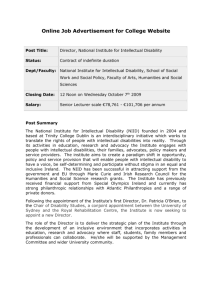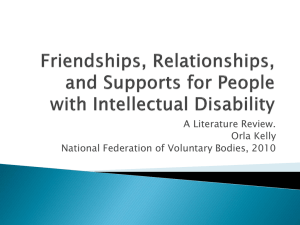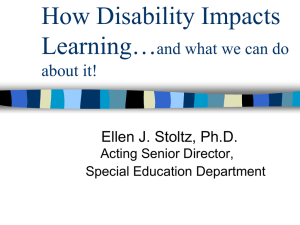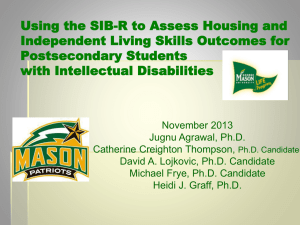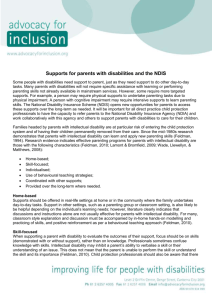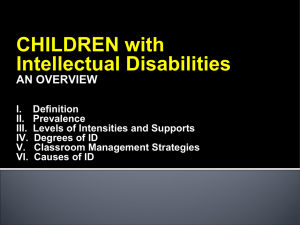Crisis Intervention Training (CIT) Autism Awareness
advertisement
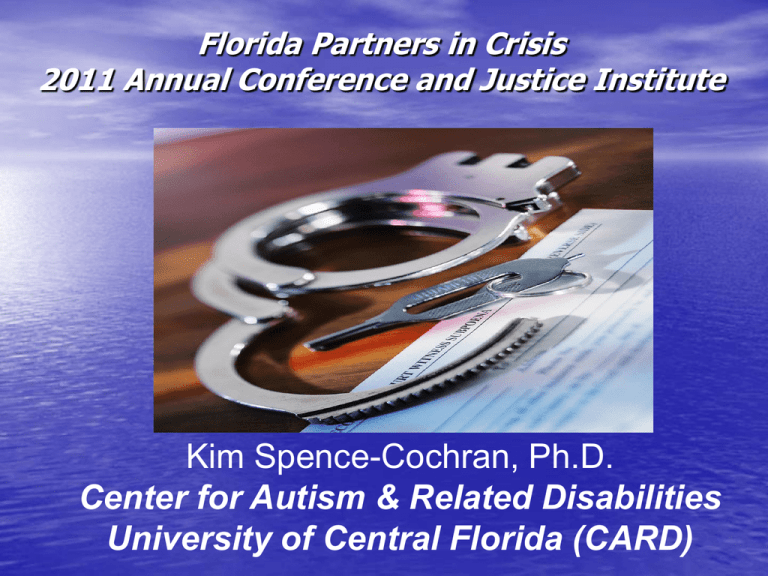
Florida Partners in Crisis 2011 Annual Conference and Justice Institute Kim Spence-Cochran, Ph.D. Center for Autism & Related Disabilities University of Central Florida (CARD) Problem solving, impulse restraint, understanding behavior of others Hearing, speech, language motor activities; planning; balance; muscles for speaking Higher mental functions; movement perception; behavioral reactions Relay station; primitive functions for survival ( ex. breathing, heart rate) Right Inferior Frontal Gyrus = Miror Neuron System (MNS) = social imitation; empathy Core Deficits of PDD: Limited Interests Communication Issues Social Skills Communication Difficulties: • Unable to provide ID or • • • • • • pertinent information Appear “guilty” May not respond to verbal commands May appear argumentative/noncompliant/stubborn Unable to answer questions in a timely fashion Ask questions as a form of answering Say things that are inappropriate or have no meaning Communication Difficulty Interventions: • Speak slowly and clearly • Do not use slang, • • • • innuendo, idioms, or rhetorical questions Do not insist on eye contact Don’t rely on body cues or gesturing Frame a clear expectation(s) Least Dangerous Assumption (LDA) Core Social Skills Deficits: • Lack of global • • • • • • understanding Difficulty with rules of engagement Lack of eye contact Lack of reciprocity Personal space issues/poor boundaries Inappropriate expression (verbal, gestures, etc.) Sensory Issues Social Difficulty Interventions: • Decrease visual or auditory or • • • • • • tactile stimulus Non-emotional response to inappropriate or socially awkward comments or statements Ask for the person to show or tell what they want/need Clear feedback regarding inappropriate behavior Establish clear boundaries if needed – use proximity control Avoid touching if possible Least Dangerous Assumption (LDA) Limited Interests Deficits: • Handle items in a manner • • • • that appears suspicious Unusual movements that appear suspicious (rocking, finger flapping, twirling items, etc.) Perseveration on routine, topic, or an item(s) Behavior that resembles a person who is chemically altered Attachment to unusual items Limited Interest Difficulty Interventions: • Attempt to ascertain item or • • • • • • topic Remember – topics of interest may be disturbing and/or unusual try not to respond to the item or topic If possible – do not remove the item or discourage vocalizations about the item or topic De-rail – if possible – try to redirect with an alternate object or item Utilize proximity control Use restraint as a last resort Least Dangerous Assumption (LDA) Mental Retardation Awareness Training Kim Spence-Cochran, Ph.D. Center For Autism and Related Disabilities University of Central Florida What is an Intellectual Disability? •Intellectual disability is a disability characterized by significant limitations both in intellectual functioning and in adaptive behavior. •This disability originates before age 18. •Individuals with ID have global problems with conceptual, social, and practical skills application and understanding. (2009 American Association on Intellectual & Developmental Disabilities) Intellectual Functioning • Mental Capability = Reasoning, planning, solving problems, thinking abstractly, comprehending complex ideas, learning quickly, learning from experience, etc. • Standardized Tests to determine Intelligence Quotient (IQ) • By definition people with ID have an average IQ that is at least 2 standard deviations below the mean Adaptive Behavior • Skills (3 subsets of specific • skills) measured by standardized Tests Collection of three skill types: conceptual, social, and practical skills – Conceptual Skills = receptive & expressive language and reading & writing – Social Skills = interpersonal skills, gullibility, following rules – Practical Skills = eating, dressing, mobility, taking medication, occupational skills Intellectual Disability versus Developmental Disability Developmental Disabilities (DD)are defined as chronic disabilities that can be cognitive or physical or both – these disabilities must appear before age 22 Intellectual disability (ID) forms a subset within the larger universe of developmental disabilities (DD) – these boundaries are often blurred ID disabilities encompass the “cognitive” part of a person’s disability Etiology of Intellectual Disability • Caused by DD, syndromes, genetic issues, • • • • • • health problems, social factors, educational factors, & environmental factors – over 200 documented causes Over 7.5 million Americans have some form of intellectual disability (roughly 3% of the population) 1 in 10 families are affected Comprises one of the largest disability groups Can not be cured ID is not a mental illness ID is not a disease Characteristics of Intellectual Disabilities • Language or behavior • • • may be delayed or immature Physical abilities may be delayed or immature Difficulty following oral directions Difficulty understanding the environment (big picture) Characteristics of Intellectual Disabilities • Social abilities may be delayed or immature • Difficulty with “relatedness” • Overall “slowness” • Physical characteristics including stunted growth, odd-shaped head and/or hands, feet, or stature Implications for Law Enforcement: • Say what they think • May easily confess, even • • • • • others want to hear Have difficulty describing facts for details (recall) Not want disability noticed VERY susceptible to coercion Confusion about who is responsible for actions though innocent Inappropriate smiling or non-verbal cues that resemble a lack of remorse Strategies for First Responders: • Speak directly to the person • Keep sentences short • Use simple language • Refrain from the use of slang or idioms • Use concrete terms • Break steps into small pieces • Use pictures when possible (visual supports) Thanks for Attending! Kim Spence-Cochran, Ph.D. P.O. Box 162202 Orlando, FL 162202 Office: 407.823.6022 Toll-free: 888.558.1908 Cell: 321-212-8997 Email: kcochran@mail.ucf.edu
